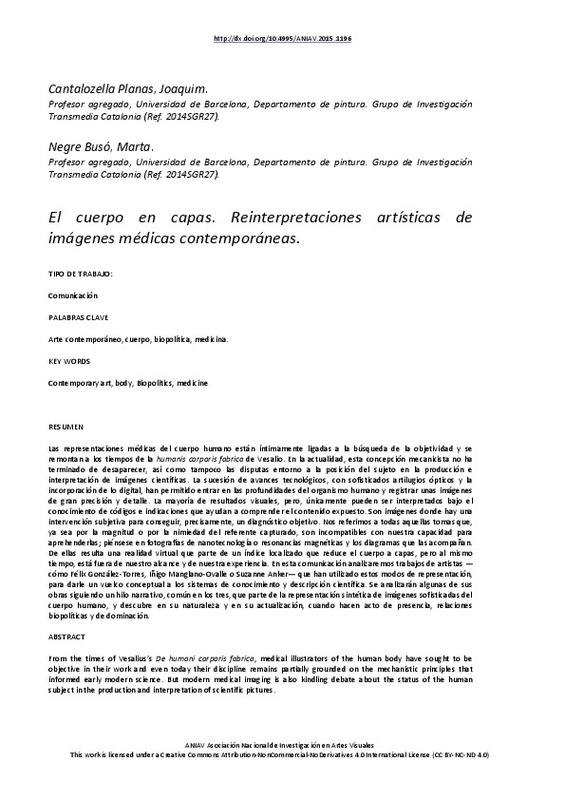JavaScript is disabled for your browser. Some features of this site may not work without it.
Buscar en RiuNet
Listar
Mi cuenta
Estadísticas
Ayuda RiuNet
Admin. UPV
El cuerpo en capas. Reinterpretaciones artísticas y biopolíticas de imágenes médicas contemporáneas
Mostrar el registro sencillo del ítem
Ficheros en el ítem
| dc.contributor.author | Cantalozella Planas, Joaquim
|
es_ES |
| dc.contributor.author | Negre Busó, Marta
|
es_ES |
| dc.date.accessioned | 2017-10-27T12:00:10Z | |
| dc.date.available | 2017-10-27T12:00:10Z | |
| dc.date.issued | 2015-11-26 | |
| dc.identifier.isbn | 9788490483411 | |
| dc.identifier.uri | http://hdl.handle.net/10251/90166 | |
| dc.description.abstract | [EN] From the times of Vesalius’s De humani corporis fabrica, medical illustrators of the human body have sought to be objective in their work and even today their discipline remains partially grounded on the mechanistic principles that informed early modern science. But modern medical imaging is also kindling debate about the status of the human subject in the production and interpretation of scientific pictures. On the one hand, nanoscale imaging techniques and digital technology have allowed us to burrow deeper into the human organism and create pictures of great precision and detail; on the other, most images can only be understood by those trained to decode the accompanying keys and footnotes. And although they are created to help health professionals reach an objective diagnosis, the pictures themselves are invariably the consequence of a subjective intervention. In other words, medical illustration today magnifies or miniaturizes human anatomy so dramatically that the non-specialist no longer gets the picture, with or without the help of a line diagram. In reducing the subject to a series of layers located in an essentially virtual environment, nanoscale photography and MRI technology have effectively removed the human body from our reach and alienated it from our general experience of life. Under the circumstances, the present paper analyzes the contribution of the artists Suzanne Anker, Félix González-Torres and Iñigo Manglano-Ovalle, who use medical imaging techniques to give a new twist to conventional systems of generating scientific knowledge and description. Specifically, the paper considers the works in which the artist’s narrative line uses synthetic representations of complex images to reveal that, in its basic nature and its various processes of selfH renewal, the human body can momentarily become a biopolitical arena in which various forces struggle for power. | es_ES |
| dc.description.abstract | [ES] Las representaciones médicas del cuerpo humano están íntimamente ligadas a la búsqueda de la objetividad y se remontan a los tiempos de la humanis corporis fabrica de Vesalio. En la actualidad, esta concepción mecanicista no ha terminado de desaparecer, así como tampoco las disputas entorno a la posición del sujeto en la producción e interpretación de imágenes científicas. La sucesión de avances tecnológicos, con sofisticados artilugios ópticos y la incorporación de lo digital, han permitido entrar en las profundidades del organismo humano y registrar unas imágenes de gran precisión y detalle. La mayoría de resultados visuales, pero, únicamente pueden ser interpretados bajo el conocimiento de códigos e indicaciones que ayudan a comprender el contenido expuesto. Son imágenes donde hay una intervención subjetiva para conseguir, precisamente, un diagnóstico objetivo. Nos referimos a todas aquellas tomas que, ya sea por la magnitud o por la nimiedad del referente capturado, son incompatibles con nuestra capacidad para aprehenderlas; piénsese en fotografías de nanotecnología o resonancias magnéticas y los diagramas que las acompañan. De ellas resulta una realidad virtual que parte de un índice localizado que reduce el cuerpo a capas, pero al mismo tiempo, está fuera de nuestro alcance y de nuestra experiencia. En esta comunicación analizaremos trabajos de artistas — cómo Félix González-Torres, Iñigo Manglano-Ovalle o Suzanne Anker— que han utilizado estos modos de representación, para darle un vuelco conceptual a los sistemas de conocimiento y descripción científica. Se analizarán algunas de sus obras siguiendo un hilo narrativo, común en los tres, que parte de la representación sintética de imágenes sofisticadas del cuerpo humano, y descubre en su naturaleza y en su actualización, cuando hacen acto de presencia, relaciones biopolíticas y de dominación. | es_ES |
| dc.format.extent | 6 | es_ES |
| dc.language | Español | es_ES |
| dc.publisher | Editorial Universitat Politècnica de València | es_ES |
| dc.relation.ispartof | II CONGRESO INTERNACIONAL DE INVESTIGACIÓN EN ARTE VISUALES | es_ES |
| dc.rights | Reconocimiento - No comercial - Sin obra derivada (by-nc-nd) | es_ES |
| dc.subject | Arte | es_ES |
| dc.subject | Producción artística | |
| dc.subject | Estética | |
| dc.subject | Teoría del arte | |
| dc.subject | Gestión cultural | |
| dc.subject | Educación artística | |
| dc.subject | Investigación artística | |
| dc.title | El cuerpo en capas. Reinterpretaciones artísticas y biopolíticas de imágenes médicas contemporáneas | es_ES |
| dc.type | Capítulo de libro | es_ES |
| dc.type | Comunicación en congreso | es_ES |
| dc.identifier.doi | 10.4995/ANIAV2015.1196 | |
| dc.rights.accessRights | Abierto | es_ES |
| dc.description.bibliographicCitation | Cantalozella Planas, J.; Negre Busó, M. (2015). El cuerpo en capas. Reinterpretaciones artísticas y biopolíticas de imágenes médicas contemporáneas. En II CONGRESO INTERNACIONAL DE INVESTIGACIÓN EN ARTE VISUALES. Editorial Universitat Politècnica de València. 146-151. https://doi.org/10.4995/ANIAV2015.1196 | es_ES |
| dc.description.accrualMethod | OCS | es_ES |
| dc.relation.conferencename | II Congreso Internacional de Investigación en Artes Visuales. |< real | virtual >| ANIAV2015 | es_ES |
| dc.relation.conferencedate | July 09-10,2015 | es_ES |
| dc.relation.conferenceplace | Valencia, Spain | es_ES |
| dc.relation.publisherversion | http://ocs.editorial.upv.es/index.php/ANIAV/ANIAV2015/paper/view/1196 | es_ES |
| dc.description.upvformatpinicio | 146 | es_ES |
| dc.description.upvformatpfin | 151 | es_ES |
| dc.type.version | info:eu-repo/semantics/publishedVersion | es_ES |
| dc.relation.pasarela | OCS\1196 | es_ES |








